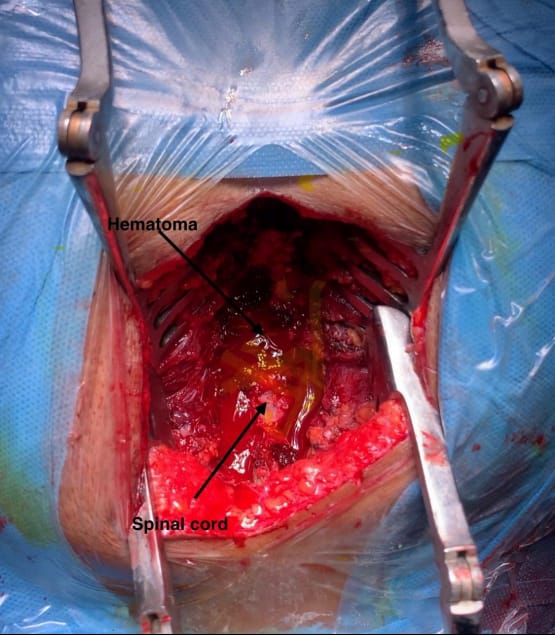Spontaneous Thoracic Epidural Hematoma Linked to Heavy Weight Lifting in a 29-Year-Old Male: A Case Report
Mots-clés :
Thoracic epidural hematoma, spontaneous, Heavy Lifting, Neurological DeficitRésumé
Background: Spontaneous spinal epidural hematoma (SSEH) is a rare and serious condition characterized by the accumulation of blood in the epidural space of the spine without any apparent cause. Although it is an uncommon clinical entity, SSEH can lead to acute neurological deficits and requires prompt intervention. This report explores the potential link between heavy lifting and the onset of SSEH in a young, otherwise healthy individual. Case Presentation: We present the case of a 29-year-old male who developed severe upper back pain following an episode of heavy lifting, which progressed to sudden paralysis. MRI revealed a thoracic epidural hematoma extending from T1 to T3, causing significant spinal cord compression. The patient underwent urgent posterior decompression surgery, which led to full neurological recovery within 24 hours. Discussion: This case underscores the potential for heavy lifting to trigger SSEH, a condition that can lead to rapid neurological decline. Early recognition, accurate diagnosis through MRI, and prompt surgical intervention are essential to prevent permanent damage and optimise patient outcomes. Conclusion: Physicians should consider SSEH in patients presenting with acute spinal cord symptoms following exertional activities like heavy lifting. Immediate intervention is crucial to ensure favourable outcomes in this rare but potentially devastating condition.
Références
Figueroa J, DeVine JG: Spontaneous spinal epidural hematoma: literature review. J Spine Surg. 2017,3: 58-63. 10.21037/jss.2017.02.04
Chu EC, Trager RJ, Lai CR, Shum JS: Spontaneous cervical epidural hematoma following COVID-19 illness presenting to a chiropractor: a case report. Cureus. 2022, 14:e32199. 10.7759/cureus.32199
Akimoto T, Yamada T, Shinoda S, Asano Y, Nagata D: Spontaneous spinal epidural hematoma as a potentially important stroke mimic. J Cent Nerv Syst Dis. 2014, 6:15-20. 10.4137/JCNSD.S13252
Peng D, Yan M, Liu T, et al.: Prognostic factors and treatments efficacy in spontaneous spinal epidural hematoma: a multicenter retrospective study. Neurology. 2022, 99:e843-50. 10.1212/WNL.0000000000200844
Roberts TT, Leonard GR, Cepela DJ: Classifications In brief: American Spinal Injury Association (ASIA) impairment scale. Clin Orthop Relat Res. 2017, 475:1499-504. 10.1007/s11999-016-5133-4
ASIA Impairment Scale (AIS) Score - Madonna Rehabilitation Hospitals [Internet]. Madonna Rehabilitation Hospitals. 2024 [cited 2025 Feb 14]. Available from: https://www.madonna.org/programs/spine-injury/asia-impairment-scale-ais-score/
Kumar Y, Hayashi D: Role of magnetic resonance imaging in acute spinal trauma: a pictorial review. BMC Musculoskelet Disord. 2016, 17:310. 10.1186/s12891-016-1169-6

Téléchargements
Publiée
Comment citer
Licence
(c) Tous droits réservés East African Journal of Neurological Sciences 2025

Ce travail est disponible sous licence Creative Commons Attribution - Pas d'Utilisation Commerciale - Pas de Modification 4.0 International.

